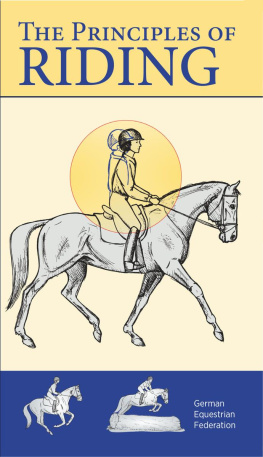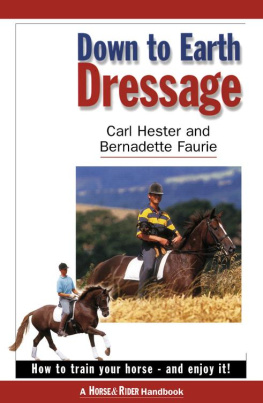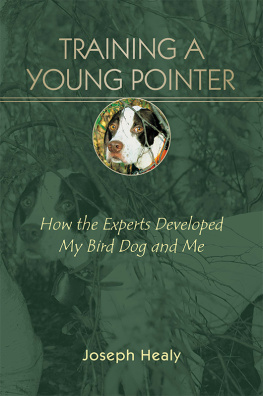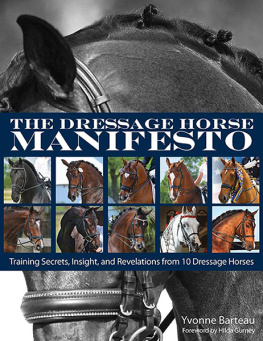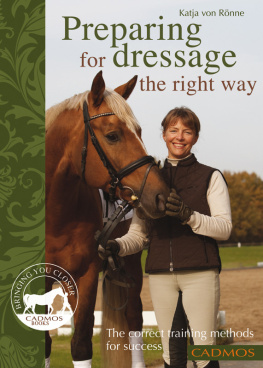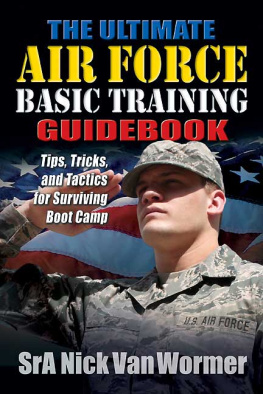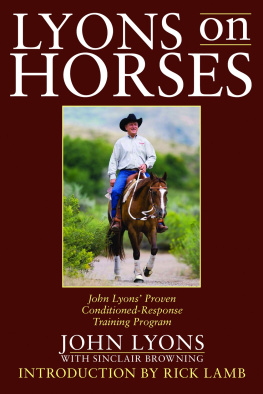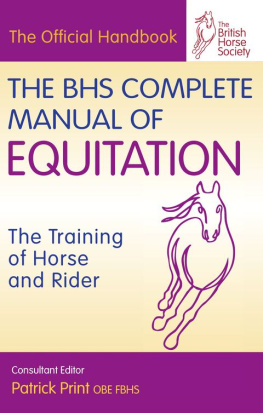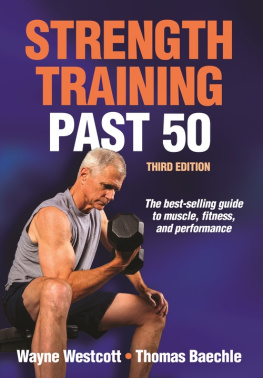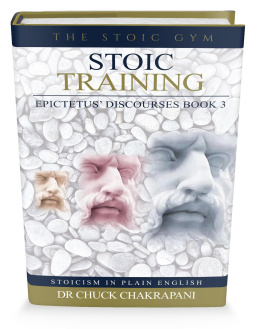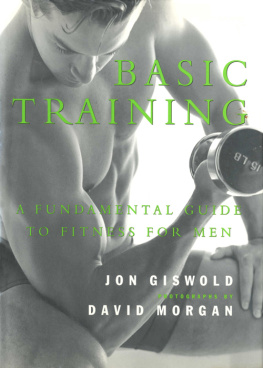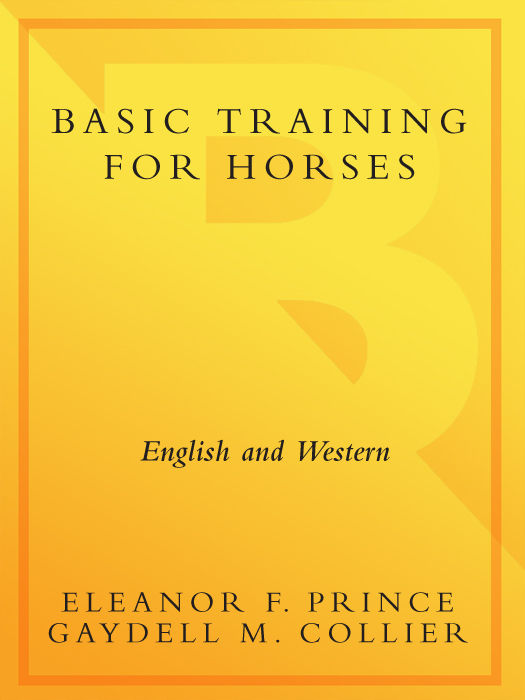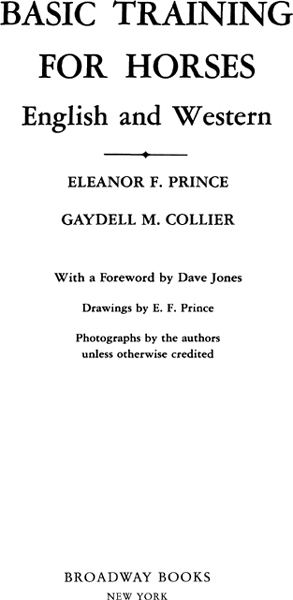By the same authors
BASIC HORSEMANSHIP: ENGLISH AND WESTERN
BASIC HORSE CARE
FOREWORD
I was very flattered, when, some time ago, I was asked to write this Foreword. To be asked to do a Foreword is a great compliment, for the authors of this book have read my writings and liked them well enough to single me out of the crowd.
Theres a lot involved in writing a Foreword. The first thing one must do is to read the book hes doing the Foreword for. When the galley proofs of this one arrived, I was amazed at the size. This is one big book.
Galleys arent easy to read. There are all sorts of corrections on them and some of the stuff isnt too clear. A guy might speed read through all this but I found myself using my magnifying glass so I could savor every word.
I found what I was looking for; compassion and understanding. Without these, such a book is a dead mechanical thing. The authors convey the feeling that they really care for horses and are extremely concerned that you who read it share their feelings.
Now, let me say this. I dont always agree with these gals. I have my methods and they have theirs. I had a lot of fun disagreeing with some of the things they wrote about.
Im an ole cowboy. Cant you see me starting a colt with a bareback pad and riding side-saddle? Heck, Will James and Charlie Russell just turned over in their graves! When I start a colt, I pull up my chaps, pull down my hat, and git on.
But the early horse masters would have liked such a method. The thought is good. Professor Rarey, the great old English horse master, would have been high with his approval.
The authors are very thorough. The person who buys this book, be he novice or professional, will find material well worth reading. Many western trainers now use dressage methods, and all this is extremely well covered.
A colt can be trained if the rider ropes him, manhandles a saddle on him, and goes for a ride. But a great many colts are spoiled by such crude methods. The slow, precise, humane way of doing things is far better, and youre told how to do it in this book.
A part I really liked was the advice to spice up the trainingto make things interesting for the colt so hell want to work. This is valuable advice. Too many trainers consider themselves teachers in the strictest sense of the word. They drill-drill-drill! The horse puts up with this drudgery day after day, week after week, and month after month. Nothinganimal, horse, dog, humancares for drudgery. Making work enjoyable for the colt is very necessary.
Someday Id like to know both authors well, for theyre my kind of people. Its easy to see that they both love horses and are serious about training them. Their sincerity comes through loud and clear. Such folks are my friends.
Dave Jones
ACKNOWLEDGMENTS
For their kind assistancewhether in providing information, helping with photos, or in other wayswe are grateful to Dave Jones, Charlotte Brailey Kneeland, Sandy Whittaker, Leslie Turner, Margaret Smith, Woodson Tyree, Dorothy R. Feldman, Helen Lund, John Galbraith, Fred and Frank Collier, Kathryn G. Hanaford, Ellin K. Roberts, the Wyoming Travel Commission, the University of Wyoming Photo Service, our husbandsBill Prince and Roy Collier, and our many other friendsboth human and equinewho have helped to make this book possible.
Eleanor F. Prince
Sodergreen Ranch, Buford,
Wyoming
Gaydell M. Collier
Backpocket Ranch, Sundance,
Wyoming
CONTENTS
Part I
Chapter 1
Chapter 2
Part II
Chapter 1
Chapter 2
Chapter 3
Chapter 4
Chapter 5
Chapter 6
Chapter 7
Part III
Chapter 1
Chapter 2
Chapter 3
Part IV
Chapter 1
Chapter 2
Part V
Chapter 1
Chapter 2
INTRODUCTION
Training is discovery. To train a horse is to discover his nature and to develop his abilities.
Every time a trainer and a prospective equine pupil first confront each other, they stand at the head of a new road, down which theyll have to travel together. There may be roadsigns and trail markers; there may be stretches of well-worn macadam; but somewhere along the way they will have to break trail and pick their way among the rocks.
Thats why, if you ask six horsemen how to train a horse, youll probably get six different answers. Ask any one of those horsemen how he trained six horses, and, chances are, youll still get six different answers.
There are many ways to train a horse, and a good trainer is sensitive, innovative, and flexible. In Basic Training for Horses: English and Western, we present training methods that have proved effective for us, and we offer ideas that we hope will challenge you to discoveryto training your horse creatively. This book is closely correlated with Basic Horsmanship: English and Western, carrying through what the student has learned as a rider to what he can apply as a trainer. The case studies and examples of ways to deal with different problems should serve as continual reminders that there is no one way, or best way, to train a horse.
In working with horses, there is always a challenge ahead. If you are thinking about training your horse, what will you have to know? Do you really want to? Are you able to? Above all, should you?
To be successful, a trainer should have:
First, an innate and deep-seated love and respect for horses, and Second, a certain amount of knowledge of and experience with horses.
Patience, common sense, and willingness to work hard are also of top importance. With these as starting points, how can you decide whether or not you should be a horse trainer? Or, a better question would be: How can you tell whether or not you should train this particular horse? Unless you are a professional trainer, experienced and equipped to handle any horse that comes your way, there is going to be a dividing line between horses you will be able to train and those you shouldnt attempt. In many cases, after a reasonable evaluation, youll be able to tell, even before you begin, whether or not to tackle that particular horse. Certainly, after several sessions and a re-evaluation, you should know whether or not to continue.
How to make this evaluation is discussed in . But first, lets take a close look at this animal called horse. Just what kind of critter is he?
Part I

THE ART OF TRAINING
CHAPTER 1
THE PSYCHOLOGY
OF TRAINING HORSES
A horse is an individual. He has his own set of physical characteristics that in some measure conform to or deviate from a breed standard. He has an individual temperament and disposition, and his background and environment have touched him in special ways. He may be wary, friendly, crafty, playful, lazy, ornery. He is himself.
But a horse is also a member of a genus and a species, and as such he has certain characteristics in common with every other horse. A working knowledge of these characteristics and behavioral traits helps the trainer to avoid mistakes and gives him the advantage he needs to progress gently but firmly in training.


